SCM供应链管理知识合作与业务管理
- 格式:pptx
- 大小:2.07 MB
- 文档页数:35
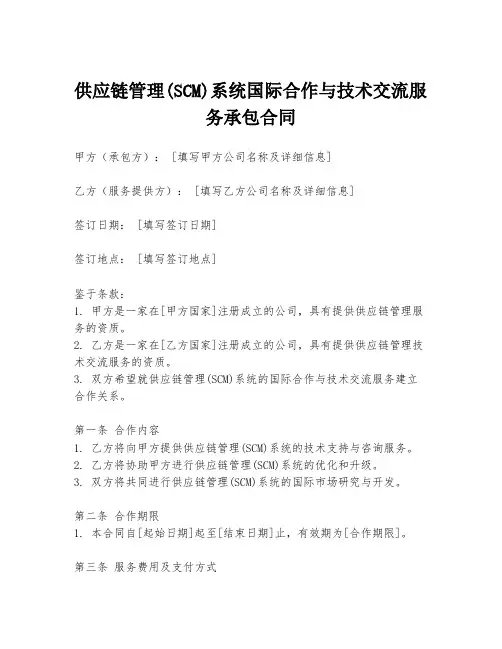
供应链管理(SCM)系统国际合作与技术交流服务承包合同甲方(承包方): [填写甲方公司名称及详细信息]乙方(服务提供方): [填写乙方公司名称及详细信息]签订日期: [填写签订日期]签订地点: [填写签订地点]鉴于条款:1. 甲方是一家在[甲方国家]注册成立的公司,具有提供供应链管理服务的资质。
2. 乙方是一家在[乙方国家]注册成立的公司,具有提供供应链管理技术交流服务的资质。
3. 双方希望就供应链管理(SCM)系统的国际合作与技术交流服务建立合作关系。
第一条合作内容1. 乙方将向甲方提供供应链管理(SCM)系统的技术支持与咨询服务。
2. 乙方将协助甲方进行供应链管理(SCM)系统的优化和升级。
3. 双方将共同进行供应链管理(SCM)系统的国际市场研究与开发。
第二条合作期限1. 本合同自[起始日期]起至[结束日期]止,有效期为[合作期限]。
第三条服务费用及支付方式1. 甲方应向乙方支付服务费用,具体金额为[金额]。
2. 服务费用的支付方式为[支付方式],支付时间点为[支付时间点]。
第四条知识产权1. 乙方提供的供应链管理(SCM)系统及相关技术,其知识产权归乙方所有。
2. 甲方在合同期内有权使用乙方提供的技术,但不得转让或许可第三方使用。
第五条保密条款1. 双方应对在合作过程中知悉的商业秘密和技术秘密负有保密责任。
2. 保密期限为合同终止后[保密期限]年。
第六条违约责任1. 如一方违反合同条款,应向守约方支付违约金,金额为[违约金金额]。
2. 因违约造成的损失,违约方应予以赔偿。
第七条争议解决1. 合同执行过程中发生的争议,双方应首先通过友好协商解决。
2. 协商不成时,可提交至[选择的仲裁机构]进行仲裁,或依法向[甲方或乙方所在地]的人民法院提起诉讼。
第八条其他条款1. 本合同的修改和补充应以书面形式进行,并经双方授权代表签字盖章后生效。
2. 本合同用[甲方和乙方的官方语言]书写,两种文本具有同等法律效力。
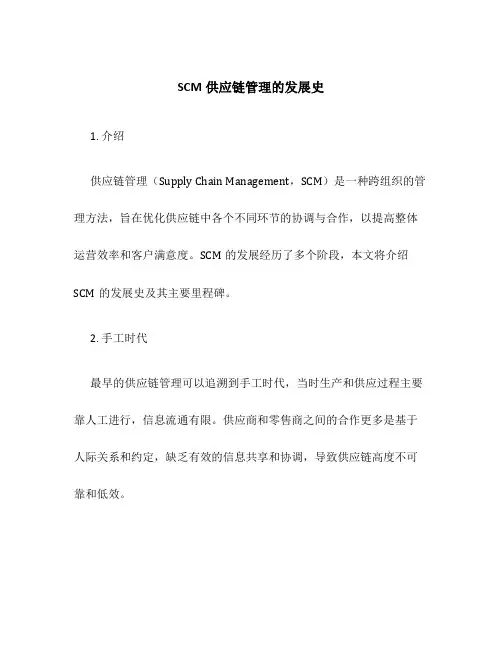
SCM供应链管理的发展史1. 介绍供应链管理(Supply Chain Management,SCM)是一种跨组织的管理方法,旨在优化供应链中各个不同环节的协调与合作,以提高整体运营效率和客户满意度。
SCM的发展经历了多个阶段,本文将介绍SCM的发展史及其主要里程碑。
2. 手工时代最早的供应链管理可以追溯到手工时代,当时生产和供应过程主要靠人工进行,信息流通有限。
供应商和零售商之间的合作更多是基于人际关系和约定,缺乏有效的信息共享和协调,导致供应链高度不可靠和低效。
3. MRP和ERP时代上世纪70年代,随着计算机技术的进步,材料需求计划(Material Requirements Planning,MRP)系统的出现标志着供应链管理的一个重要里程碑。
MRP能够根据市场需求以及物料的库存和采购情况,自动计算物料的需求量和供应计划,提高了供应链的计划性和准确性。
随后,企业资源计划(Enterprise Resource Planning,ERP)系统的发展进一步推动了供应链管理的发展。
ERP将企业的各个部门和业务流程整合到一个系统中,提供了更全面、实时的信息流通和协调能力,使得供应链管理得以全面优化。
4. JIT和TQM时代上世纪80年代,精益生产(Just-in-Time,JIT)和全面质量管理(Total Quality Management,TQM)成为了供应链管理的重要理念。
JIT强调在不浪费资源的前提下实现高效的生产和供应,并通过紧密合作和信息共享实现产能和库存的最优化。
TQM着重于产品和流程的质量管理,通过确保质量标准的一致性和持续改进,提高供应链的可靠性和客户满意度。
5. ECR和CPFR时代上世纪90年代,快速消费品行业提出了电子商务重补货(Efficient Consumer Response,ECR)的理念,强调通过信息技术和供应链协同,实现零售商和供应商之间的高效沟通和准确补货。

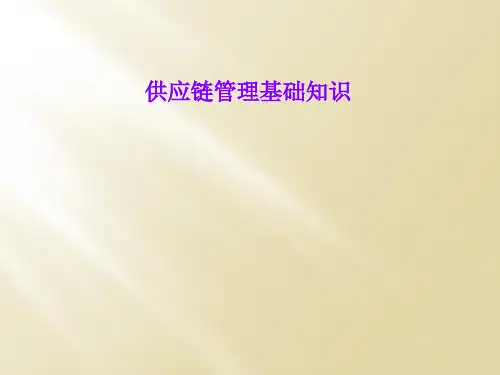
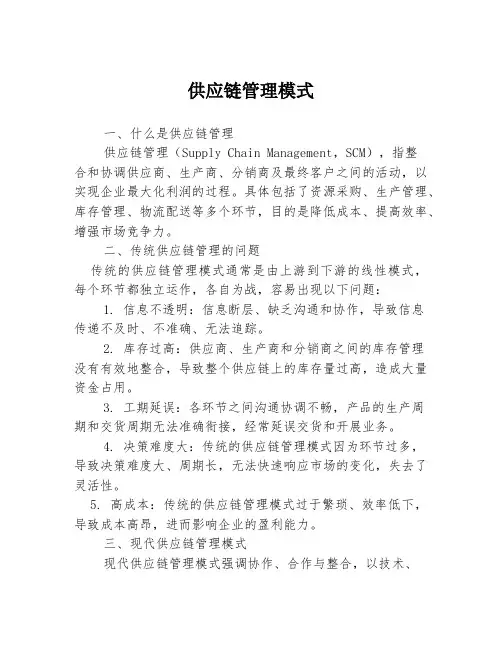
供应链管理模式一、什么是供应链管理供应链管理(Supply Chain Management,SCM),指整合和协调供应商、生产商、分销商及最终客户之间的活动,以实现企业最大化利润的过程。
具体包括了资源采购、生产管理、库存管理、物流配送等多个环节,目的是降低成本、提高效率、增强市场竞争力。
二、传统供应链管理的问题传统的供应链管理模式通常是由上游到下游的线性模式,每个环节都独立运作,各自为战,容易出现以下问题:1. 信息不透明:信息断层、缺乏沟通和协作,导致信息传递不及时、不准确、无法追踪。
2. 库存过高:供应商、生产商和分销商之间的库存管理没有有效地整合,导致整个供应链上的库存量过高,造成大量资金占用。
3. 工期延误:各环节之间沟通协调不畅,产品的生产周期和交货周期无法准确衔接,经常延误交货和开展业务。
4. 决策难度大:传统的供应链管理模式因为环节过多,导致决策难度大、周期长,无法快速响应市场的变化,失去了灵活性。
5. 高成本:传统的供应链管理模式过于繁琐、效率低下,导致成本高昂,进而影响企业的盈利能力。
三、现代供应链管理模式现代供应链管理模式强调协作、合作与整合,以技术、信息和流程为基础,实现上游与下游各环节之间的协作性和信息实时共享。
主要包括以下几个方面的途径:1. 信息共享和透明使用信息技术实现供应链内各个环节的数据交互,保证信息的实时共享和透明。
如:供应商通过ERP系统向生产商提供所需原材料的信息,生产商通过MES系统向供应商的库存信息等进行反馈,分销商通过协同系统向生产商反馈市场反馈等。
2. 整体库存管理采用物流管理技术,对供应链内的库存进行整合和管理,达到合理利用和降低存货成本的目的。
具体做法是,通过供应链协同技术,实现库存信息的实时共享和整合,动态调整库存路径和存货量。
利用物流运输技术,实现物料快速响应以及精确调配和分配,提高配送效率、降低成本。
3. 安排产品的流动采用专业化的物流运输企业,通过整体规划和协同调配,保证产品的有序流动。
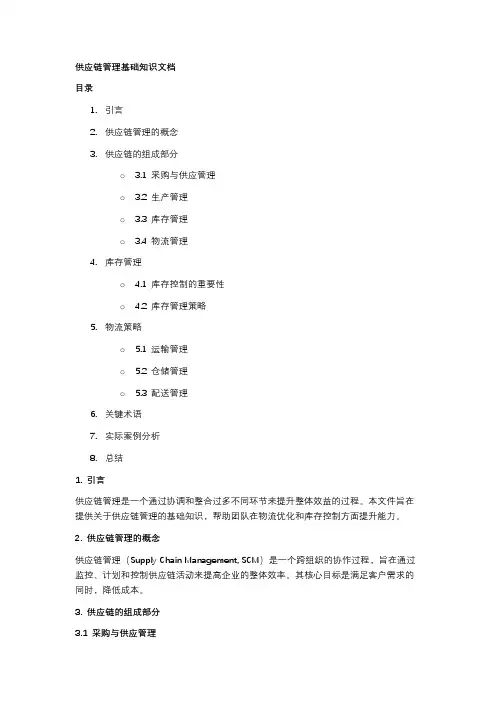
供应链管理基础知识文档目录1.引言2.供应链管理的概念3.供应链的组成部分o 3.1 采购与供应管理o 3.2 生产管理o 3.3 库存管理o 3.4 物流管理4.库存管理o 4.1 库存控制的重要性o 4.2 库存管理策略5.物流策略o 5.1 运输管理o 5.2 仓储管理o 5.3 配送管理6.关键术语7.实际案例分析8.总结1. 引言供应链管理是一个通过协调和整合过多不同环节来提升整体效益的过程。
本文件旨在提供关于供应链管理的基础知识,帮助团队在物流优化和库存控制方面提升能力。
2. 供应链管理的概念供应链管理(Supply Chain Management, SCM)是一个跨组织的协作过程,旨在通过监控、计划和控制供应链活动来提高企业的整体效率。
其核心目标是满足客户需求的同时,降低成本。
3. 供应链的组成部分3.1 采购与供应管理负责选择供应商、谈判合同、管理供应关系,并确保物料及时供应。
3.2 生产管理涉及产品的生产规划与调度、质量控制以及生产过程管理。
3.3 库存管理管理和控制库存水平,以平衡客户需求与持有成本。
3.4 物流管理涉及货物的运输、仓储和配送,以确保有效的物流网络。
4. 库存管理4.1 库存控制的重要性良好的库存管理能够减少库存成本、避免缺货及过量库存,确保供应链的流畅运作。
4.2 库存管理策略•经济订购量(EOQ):计算最优订购数量,以最低的总成本满足需求。
•ABC分类法:根据价值和需求频率对库存物品进行分类,优化管理资源。
•安全库存:设立额外库存以应对需求波动。
5. 物流策略5.1 运输管理选择最佳的运输方式和路径,以确保及时送达,同时降低运输成本。
5.2 仓储管理有效的仓储可以降低运营成本,提高货物周转效率。
可以采用先进的仓储管理系统(WMS)来优化策略。
5.3 配送管理制定高效的配送计划,确保货物按照客户要求的时间和数量及时送达。
6. 关键术语•供应链(Supply Chain):从原材料、生产到最终产品交付给客户的整个环节。
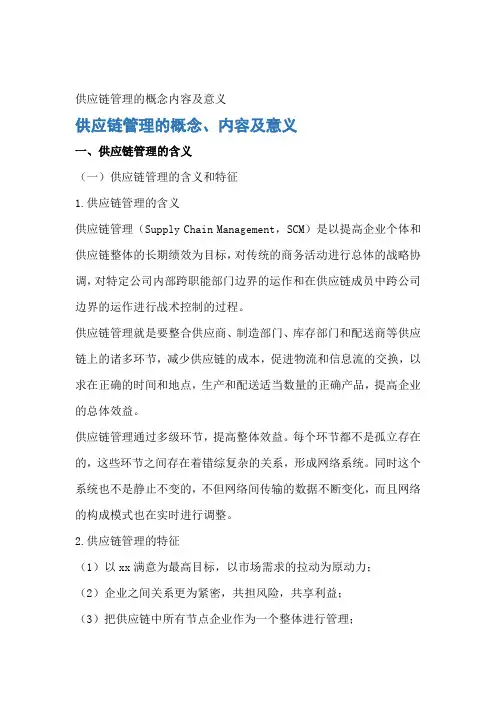
供应链管理的概念内容及意义供应链管理的概念、内容及意义一、供应链管理的含义(一)供应链管理的含义和特征1.供应链管理的含义供应链管理(Supply Chain Management,SCM)是以提高企业个体和供应链整体的长期绩效为目标,对传统的商务活动进行总体的战略协调,对特定公司内部跨职能部门边界的运作和在供应链成员中跨公司边界的运作进行战术控制的过程。
供应链管理就是要整合供应商、制造部门、库存部门和配送商等供应链上的诸多环节,减少供应链的成本,促进物流和信息流的交换,以求在正确的时间和地点,生产和配送适当数量的正确产品,提高企业的总体效益。
供应链管理通过多级环节,提高整体效益。
每个环节都不是孤立存在的,这些环节之间存在着错综复杂的关系,形成网络系统。
同时这个系统也不是静止不变的,不但网络间传输的数据不断变化,而且网络的构成模式也在实时进行调整。
2.供应链管理的特征(1)以xx满意为最高目标,以市场需求的拉动为原动力;(2)企业之间关系更为紧密,共担风险,共享利益;(3)把供应链中所有节点企业作为一个整体进行管理;库存原材料在制品分销销售点最终制造采购分销零售用户供应商供应链管理的概念内容及意义图1-4 供应链管理的范围(4)对工作流程、实物流程和资金流程进行设计、执行、xx和不断改进;(5)利用信息系统优化供应链的运作;(6)缩短产品完成时间,是生产尽量贴近实时需求;(7)减少采购、库存、运输等环节的成本。
以上特征中,(1)(2)(3)是供应链管理的实质,(4)(5)是实施供应链管理的两种主要方法,而(6)(7)则是实施供应链管理的主要目标,即从时间和成本两个方面为产品增值,从而增强企业的竞争力。
二、供应链管理的内容作为供应链中各节点企业相关运营活动的协调平台,供应链管理应把重点放在以下几个方面:(一)供应链战略管理。
供应链管理本身属于企业战略层面的问题,因此,在选择和参与供应链时,必须从企业发展战略的高度考虑问题。
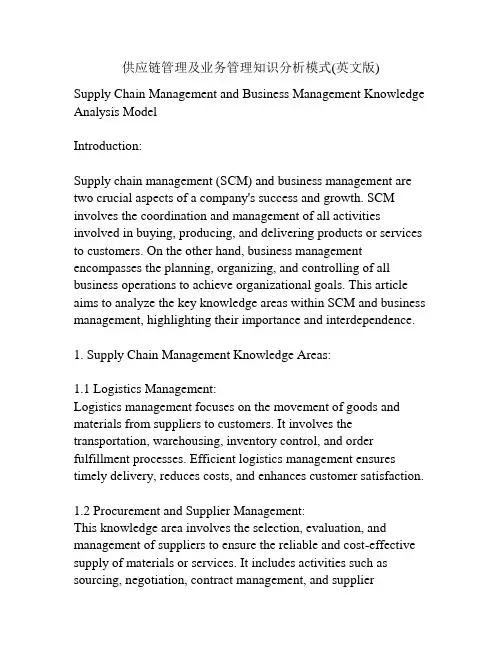
供应链管理及业务管理知识分析模式(英文版) Supply Chain Management and Business Management Knowledge Analysis ModelIntroduction:Supply chain management (SCM) and business management are two crucial aspects of a company's success and growth. SCM involves the coordination and management of all activities involved in buying, producing, and delivering products or services to customers. On the other hand, business management encompasses the planning, organizing, and controlling of all business operations to achieve organizational goals. This article aims to analyze the key knowledge areas within SCM and business management, highlighting their importance and interdependence.1. Supply Chain Management Knowledge Areas:1.1 Logistics Management:Logistics management focuses on the movement of goods and materials from suppliers to customers. It involves the transportation, warehousing, inventory control, and order fulfillment processes. Efficient logistics management ensures timely delivery, reduces costs, and enhances customer satisfaction.1.2 Procurement and Supplier Management:This knowledge area involves the selection, evaluation, and management of suppliers to ensure the reliable and cost-effective supply of materials or services. It includes activities such as sourcing, negotiation, contract management, and supplierperformance measurement.1.3 Demand Planning and Forecasting:Demand planning and forecasting involve the estimation of future customer demand for products or services. It helps in the optimization of inventory levels, production planning, and resource allocation. Accurate forecasting reduces stockouts, minimizes inventory carrying costs, and improves customer service.1.4 Inventory Management:Inventory management encompasses the control and optimization of inventory levels to meet customer demands while minimizing holding costs. It includes inventory classification, safety stock determination, replenishment strategies, and utilization of advanced inventory management techniques like just-in-time (JIT) and economic order quantity (EOQ).1.5 Risk Management:Supply chain risk management involves identifying, assessing, and mitigating risks associated with supply chain operations. It includes evaluating risks related to supplier reliability, demand volatility, transportation disruptions, natural disasters, and geopolitical factors. Effective risk management helps in minimizing potential disruptions and ensuring business continuity.2. Business Management Knowledge Areas:2.1 Strategic Planning:Strategic planning involves setting the long-term goals and direction of the company. It includes analyzing internal andexternal factors, conducting market research, defining the company's mission and vision, and formulating strategies to achieve competitive advantage. Strategic planning provides a roadmap for decision-making and resource allocation.2.2 Financial Management:Financial management focuses on the efficient utilization and allocation of financial resources within the company. It includes budgeting, financial analysis, cash flow management, and capital investment decisions. Effective financial management ensures profitability, liquidity, and sustainability of the business.2.3 Organizational Behavior:Organizational behavior refers to understanding individual and group dynamics within the company. It includes topics like motivation, leadership, communication, team dynamics, and organizational culture. Understanding and managing organizational behavior promotes employee engagement, productivity, and effective teamwork.2.4 Marketing and Sales Management:Marketing and sales management involves the identification of target markets, development of marketing strategies, and implementation of promotional activities to achieve sales objectives. It includes market research, product development, pricing, distribution, and customer relationship management. Effective marketing and sales management drive customer acquisition, retention, and revenue generation.2.5 Operations Management:Operations management focuses on the design, control, and improvement of production processes to deliver products or services efficiently. It includes capacity planning, production scheduling, quality management, and continuous process improvement. Effective operations management increases productivity, reduces costs, and ensures customer satisfaction.Conclusion:Supply chain management and business management are interconnected and essential for the success of any company. A comprehensive knowledge analysis model helps to identify and prioritize key knowledge areas within these domains. Companies that effectively manage their supply chains and employ sound business management principles gain a competitive edge, achieve operational excellence, and sustain long-term growth and profitability.3. Interdependence between Supply Chain Management and Business Management:The interdependence between supply chain management and business management is crucial for the overall success and growth of a company. While supply chain management focuses on the operational aspects of sourcing, production, and delivery, business management provides the strategic framework and direction for these activities. The knowledge areas within both domains are interconnected and rely on each other for effective decision-making and implementation.For example, strategic planning plays a significant role in both supply chain management and business management. A company'sstrategic objectives and goals influence its supply chain strategy, such as sourcing strategies, selection of suppliers, and distribution network design. On the other hand, the company's supply chain capabilities and constraints impact its overall strategic decisions, such as market entry strategies, product differentiation, and pricing.Similarly, financial management is essential for both supply chain management and business management. Efficient financial management helps in allocating resources effectively within the supply chain, such as optimizing inventory levels, implementing cost-saving measures, and improving cash flow. It also enables the company to make informed business decisions, such as investing in new technologies or expanding into new markets.Organizational behavior plays a critical role in both domains as well. Effective communication, teamwork, and leadership within the supply chain contribute to smooth coordination and collaboration among various stakeholders. In business management, understanding organizational behavior helps in creating a positive work culture, motivating employees, and fostering innovation, thereby leading to better business performance and customer satisfaction.Marketing and sales management are interconnected with supply chain management as well. Market research and customer insights are crucial in demand planning and forecasting, which informs supply chain decisions, such as production levels, inventory management, and transportation requirements. Conversely, supply chain capabilities influence marketing and sales strategies, such as product availability, delivery speed, and customer service levels.Integration between these knowledge areas ensures alignment between supply and demand, resulting in customer satisfaction and competitive advantage.Furthermore, operations management plays a key role in both supply chain management and business management. Efficient operations management techniques, such as lean manufacturing, Six Sigma, and total quality management, improve productivity, reduce waste, and enhance product/service quality. These improvements, in turn, enhance the company's overall performance and competitiveness. Additionally, operations management principles help in optimizing supply chain processes, such as production scheduling, inventory management, and order fulfillment, leading to cost savings, shorter lead times, and improved customer satisfaction.4. Importance of Supply Chain Management and Business Management Knowledge:The knowledge areas within supply chain management and business management are crucial for companies to remain competitive, adapt to changing market dynamics, and drive overall business success. Below are the key reasons why companies should prioritize and invest in these knowledge areas:4.1 Optimal Resource Utilization:Efficient supply chain management ensures optimal utilization of resources, such as raw materials, production capacity, and transportation, resulting in cost savings and improved profitability. Likewise, effective business management helps in allocatingfinancial, human, and technological resources to their best possible use, maximizing the value generated by the company.4.2 Enhanced Customer Satisfaction:Supply chain management focuses on meeting customer demands by ensuring the availability of products/services, on-time delivery, and quick response to customer queries. This improves customer satisfaction and loyalty. Business management, meanwhile, helps in developing effective marketing and sales strategies, understanding customer preferences, and delivering superior customer service, further enhancing customer satisfaction and building long-term relationships.4.3 Risk Mitigation and Resilience:Supply chain management knowledge areas, such as risk management and procurement, help in identifying and mitigating potential risks to the supply chain, including disruptions from suppliers, transportation issues, or natural disasters. Business management complements these efforts by implementing suitable risk management strategies at the organizational level, such as diversifying revenue streams, implementing robust financial controls, and building strong relationships with key stakeholders. This ensures business continuity and resilience.4.4 Competitive Advantage:Companies that excel in supply chain management gain a competitive advantage by offering better value to customers through lower costs, higher product quality, and faster delivery. Similarly, effective business management, through strategic planning, marketing, and operations, helps companies differentiatethemselves from competitors and create unique value propositions that attract and retain customers.4.5 Innovation and Agility:Both supply chain management and business management knowledge areas foster innovation and agility within organizations. Supply chain innovation, such as implementing advanced technologies like automation, AI, and IoT, improves operational efficiency, reduces costs, and enables faster response to market changes. Business management knowledge areas, such as strategic planning and organizational behavior, help in creating a culture of innovation, driving continuous improvement, and fostering agile decision-making.Conclusion:Effective supply chain management and business management are critical for the success of any company. The knowledge areas within these domains are interconnected and mutually dependent. Companies that prioritize and invest in these knowledge areas gain a competitive edge, achieve operational excellence, and sustain long-term growth and profitability. Understanding and implementing the key principles and practices within supply chain management and business management enable companies to optimize resources, enhance customer satisfaction, mitigate risks, and leverage opportunities for innovation and competitive advantage.。

供应链管理知识点整理供应链管理是指企业在产品从原料采购到最终产品的销售过程中,全面管理和控制各个环节的活动,以提高供应链的效率和效益的一种管理方法。
它涉及到采购、生产、库存、物流、销售等多个方面,以下是供应链管理的知识点整理。
1.供应链管理的概念和目标:-供应链管理的概念和定义-供应链管理的目标和意义-供应链管理与传统管理的区别2.供应链管理的基本流程:-供应链战略规划-供应链网络设计-供应链合作与协调-供应链流程管理-供应链性能评估与改进3.供应链各环节的具体管理内容:-供应链战略管理:包括供应链定位、供应链组织和资源规划等内容-供应链供应管理:包括供应商选择、谈判、合作关系管理等内容-供应链生产管理:包括生产计划、工艺改进、质量控制等内容-供应链库存管理:包括库存控制、仓储与物流、库存评估等内容-供应链销售管理:包括市场预测、订单管理、客户关系管理等内容4.供应链管理的工具和技术:-ERP系统:企业资源计划系统,用于整合和管理企业的各个环节-SCM系统:供应链管理系统,用于协调供应链各环节的活动和信息流-RFID技术:射频识别技术,用于实时追踪和管理物流信息-JIT生产:即时生产,用于实现产品的按需生产和减少库存-ECR流程:效益连锁反应流程,用于缩短供应链流程和减少库存5.供应链管理的挑战和解决方案:-供需不平衡:如需求波动、原材料短缺等,可以通过合理的订单管理和供应链预测来解决-多元化需求:如定制化产品需求,可以通过灵活的供应链设计和生产管理来满足-信息不对称:如信息传递不及时、准确等,可以通过信息技术和电子数据交换来解决-品质控制问题:如产品质量不稳定、供应商质量问题等,可以通过建立供应链合作和监督机制来解决以上是供应链管理的知识点整理,供应链管理是企业提高运营效率和效益的重要手段,对于企业的竞争力和市场地位具有重要的影响。
理解和掌握以上知识点,可以帮助企业建立有效的供应链管理体系,提高整体竞争力。

SCM供应链管理协作1. 引言供应链管理(Supply Chn Management,SCM)是指几个组织通过协调流动的产品和信息,共同完成对市场需求的满足的过程。
SCM的目标是在成本最低的前提下,提供高质量的产品和服务,以满足客户需求。
为了实现高效的供应链管理,供应链参与者之间需要进行协作。
本文将重点介绍SCM供应链管理协作的重要性以及协作的方法。
2. SCM供应链管理协作的重要性SCM供应链管理协作的重要性体现在以下几个方面:2.1 提高效率供应链中的每个参与者都扮演着不同的角色,如供应商、制造商、分销商和零售商等。
通过协作,供应链中的各个环节可以紧密衔接,实现信息的快速共享和及时传递。
这将大大提高整个供应链的运作效率,减少潜在的问题和延误。
2.2 降低成本供应链的最终目标之一是降低成本。
通过协作,供应链中的各个参与者可以共同制定采购策略、生产计划和库存管理方案等。
合理的资源分配和协调可以减少不必要的浪费和库存积压,从而降低整个供应链的运营成本。
2.3 提升客户满意度供应链管理的核心是满足客户需求。
通过协作,供应链参与者可以共同关注客户的需求,根据市场情况做出相应调整,并及时响应客户的变化需求。
这将带来更好的交付性能、更高的产品质量和更好的服务水平,从而提升客户满意度。
3. SCM供应链管理协作的方法在实际操作中,可以采用以下方法来实现SCM供应链管理协作:3.1 信息共享供应链参与者之间的信息共享是实现协作的基础。
通过建立统一的信息平台,供应链参与者可以实时了解产品需求、库存情况和交付状态等信息。
这有助于提高各个环节之间的协调性,减少信息传递的误差和延误。
3.2 合作伙伴关系管理建立稳定且可信赖的合作伙伴关系是实现协作的关键。
供应链参与者应该建立长期的战略合作伙伴关系,共同制定供应链管理策略和目标。
通过持续的沟通和互动,可以加强相互间的理解和信任,提高协作效果。
3.3 协同规划与决策供应链管理涉及到多个环节的决策,如采购计划、生产计划和库存管理等。

供应链管理基础知识梳理在当今全球化的商业环境中,供应链管理已成为企业成功的关键因素之一。
无论是大型跨国企业还是小型本地公司,有效的供应链管理都能帮助其提高效率、降低成本、增强竞争力。
那么,什么是供应链管理?它包括哪些基本环节和重要概念呢?接下来,让我们一起梳理一下供应链管理的基础知识。
一、供应链管理的定义与目标供应链管理,简单来说,就是对从原材料采购到产品销售给最终客户的整个过程中,涉及的物流、信息流和资金流进行有效的规划、组织、协调和控制。
其主要目标有以下几个方面:1、提高客户满意度:确保产品或服务能够按时、按质、按量地交付给客户,满足他们的需求和期望。
2、降低成本:通过优化供应链流程,减少库存、运输、采购等环节的成本,提高企业的盈利能力。
3、提高供应链的响应速度:能够快速应对市场变化和客户需求的波动,及时调整生产和供应计划。
4、增强供应链的灵活性和适应性:适应不同的市场环境和业务模式,例如应对突发事件、新产品推出等。
二、供应链的基本环节1、计划这是供应链管理的首要环节,包括需求预测、生产计划、库存计划等。
准确的计划能够避免库存积压或缺货的情况发生,提高供应链的效率。
2、采购涉及原材料、零部件和服务的采购。
采购环节需要考虑供应商的选择、采购合同的签订、采购成本的控制等。
3、生产将原材料转化为成品的过程,包括生产流程的设计、生产进度的控制、质量控制等。
4、物流包括运输、仓储、配送等活动,确保产品能够及时、准确地送达目的地。
5、销售将产品推向市场,实现销售的过程,包括市场调研、销售渠道的选择、客户关系管理等。
三、供应链管理的关键概念1、库存管理库存是供应链中的重要资产,但过多的库存会占用资金,增加成本;过少的库存则可能导致缺货,影响客户满意度。
因此,需要通过合理的库存管理策略,如经济订货量模型、ABC 分类法等,来平衡库存成本和服务水平。
2、供应商关系管理与供应商建立长期、稳定、互利的合作关系对于供应链的成功至关重要。
供应链管理的概念及基本原理供应链管理(Supply Chain Management,SCM)是一个全新、高效的企业管理模式。
它将企业与其供应商、分销商和客户之间的关系,结合为一个系统,从而形成了一种协调整个供应链、达到最佳运营状态的方式。
企业通过SCM,可更好地把握市场动态、实现供应链整合、提高效率降低成本、增强竞争力,以及快速响应市场需求等方面优势。
一、供应链管理的概念1.定义:供应链管理是指在整个供应链(包括供应商、企业、分销商和客户)中运用一系列现代企业管理方法和理论,通过信息共享、资源整合、协调配合、风险分享的方式,在现有的资源系统中实现对产品、信息和资金的有效整合,从而形成一整套始于原材料采购、到生产经营、到销售客户的一系列全过程管理。
2.特征:(1)全链条化:从供应商到终端用户整个过程都纳入到整个供应链的范围之内。
(2)共享化:信息、资源和责任等在供应链环节之间共享。
(3)协作化:供应链各环节之间协作共同完成产品服务的供给流。
(4)高效化:通过提高物流效率来降低整个供应链成本。
(5)完整化:供应链管理应该实现整个业务流程的全过程管理。
二、供应链管理的基本原理1.流程重组以客户为中心,将所有业务的流程、机制、技术建设、人员整合到一个系统之中。
构建完整的生产与供应链,从原材料采购到产品制造,再到流通销售和售后服务,打造全链条的供应链管理流程。
2.信息化建设信息化建设的意义是通过自动化提高信息的共享和协作。
如建立ERP、MES 等管理系统,强化物流系统的支持,进一步提高供应链管理效率。
3.组织优化组织优化是指通过内部各环节间的协调合作,从而实现供应链各环节间的协同作用,如申请财务的审批、库房管理与销售出库的协调,支持了更快捷的物流管理。
4.分供应商的选择选择合适的供应商有效的降低供应链成本,优先选择具备优势的价格、质量和交付时间的供应商,根据实际供应链的需求对供应商进行分层次、分领域的管理。
什么是供应链管理(SCM)?
供应链管理(Supply Chain Management,SCM)是指在产品或服务从原材料采购、生产加工、物流运输、到最终销售和售后服务的全过程中,对供应链各个环节进行计划、协调和控制的管理活动。
供应链管理旨在通过优化各个环节的资源配置和协同合作,实现供应链整体效率和效益的最大化,从而提高企业的竞争力和客户满意度。
供应链管理涉及以下几个主要方面:
供应链规划:根据市场需求和销售预测,制定供应链的战略规划和运营计划,包括生产计划、库存管理、采购计划等。
供应商选择与管理:选择合适的供应商和合作伙伴,建立稳定、高效的供应链网络,进行供应商评估、合同管理和供应商绩效评价。
物流与运输管理:优化物流配送方案,确保产品或物料的准时交付和成本最优化,包括运输方式选择、货物跟踪、仓储管理等。
库存管理:通过合理的库存控制和优化的库存策略,平衡供需关系,降低库存成本,减少库存风险。
生产计划与调度:根据市场需求和生产能力,制定生产计划和生
产调度方案,实现生产资源的有效利用和生产效率的提高。
供应链协同与信息共享:加强供应链各个环节之间的协同合作和信息共享,实现信息的实时传递和业务流程的协同优化。
供应链风险管理:识别和评估供应链中存在的各种风险,包括供应风险、需求风险、物流风险等,制定风险应对策略和应急预案。
通过有效的供应链管理,企业可以实现生产成本的降低、生产周期的缩短、库存水平的优化、客户服务水平的提高等多方面的效益,从而提高企业的竞争力和市场占有率。